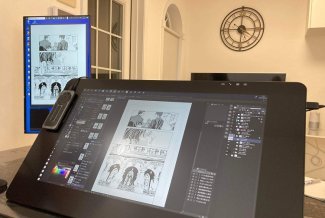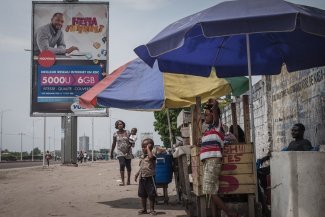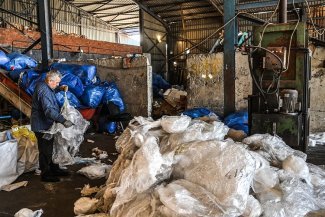A Cambodian woman weaves a cloth in the traditional way, close to Kompong Cham, in the country’s north-east.
The Oma people, a small indigenous community in Laos, are the antithesis of the speed of today’s fashion industry. The streets of their small villages in the mountains of the country’s north are not attractive enough for the large brands and the Oma continue to diligently weave their own clothing at home, preserving a unique style passed on from generation to generation that can only be found in this Asian country.
That is, until a few months ago, when their embroidery designs began to appear half-way around in the world in the stores of Italian luxury clothing brand Max Mara. According to the Traditional Arts and Ethnology Centre (TAEC), an organisation that works to preserve cultural diversity in Laos, the brand plagiarised these traditional designs in one of their collections without acknowledging their authorship. “I have no problem with inspiration. But when you put them next to each other you see that the colours and designs are the same. It’s clearly plagiarism,” says Tara Gujadhur, TAEC’s co-director.
It’s not the first time that an ethnic group has seen its cultural heritage for sale in the stores of world-renowned fashion designers, many of them luxury brands. Louis Vuitton, for example, angered the Maasai people of Kenya by copying their styles, while Christian Dior was accused last year of copying a traditional jacket from the Bihor region of Romania. One of the most recent controversies surrounded Carolina Herrera, who used indigenous Mexican designs in her Resort 2020 line. The line, inspired by “the playful and colourful mood of a Latin holiday” as the Venezuelan fashion designer describes it on her website, infuriated the Mexican government, which filed a formal complaint with the brand and its designer Wes Gordon.
But what these designers view merely as inspiration is for many activists a common practice that devalues the cultural heritage of Indigenous peoples and threatens their survival.
“We worry that making these designs available to the general public decreases their value,” says Gujadhur. As she argues, Max Mara copied the designs of the Oma people and mechanised their production, causing them to lose much of their wealth. According to a statement issued by TAEC, “To date, Max Mara has not acknowledged the Oma in marketing, labelling, or display of the collection in their stores or online shop, or provide [sic] compensation to the original artists.”
Current international frameworks do not protect the claims of the Oma or other indigenous groups. As Monica Boța Moisin, a lawyer specialising in indigenous fashion and property law explains, intellectual property laws are based on a 17th century model of individual copyright that excludes protection for community production, including for indigenous communities, because “[specific] authors cannot be recognised.”
While the Universal Declaration of Human Rights, adopted in 1948, recognises the rights of all people to “freely participate in the cultural life of the community” and the resulting benefits, no concrete agreement was reached to put in place an international legal framework protecting the artistic rights of communities. “It’s very difficult to reach an agreement on the boundaries between protection and creative restriction,” says Moison. However, this lack of protection has led to a “paradoxical and unethical” situation in which “you can put a [fashion brand’s] label on a traditional design,” she argues. “[Indigenous communities] should be entitled to some kind of protection under which at the very least their consent must be obtained.”
This might be beginning to change. Following the controversy involving Carolina Herrera, the Mexican government announced that it would introduce a new law to protect the country’s cultural wealth and the artisans who earn their livelihoods from it. “This is a principle of ethical consideration that…requires us to call attention to and put on the table an urgent matter…: promoting inclusion and making the invisible visible,” wrote Mexico’s Secretary of Culture Alejandra Frausto in a letter to Carolina Herrera, as reported by several Mexican newspapers and the Spanish daily El País.
For indigenous activist Matcha Phorn-in, the commercialisation of designs in Thailand, a country where the fake garments of mountain tribes can be found in virtually every tourist market, is leading to a loss of traditional knowledge. “Tourists find them for cheap at street markets and then want to pay the same price when they go to rural areas. But it doesn’t take the same amount of time to make them,” she explains. “They no longer earn money so the new generations don’t stay at home or learn how to do it.” Similar trends are occurring in other Asian countries where artisans, such as those who make traditional Cambodian kramas or Indonesian batik, have had to adapt to mechanisation and commercialisation.
Cooperating to survive
The clothing that the Oma weave is not their daily sustenance, which consists of the rice, bananas and corn that they grow and the rubber that they obtain from nearby plantations. According to Gujadhur, the money they make with their designs is critical to ensuring that they don’t constantly live on the edge of poverty and allowing them certain ‘luxuries’, like better feeding their children or paying for school fees. “Craftwork is an additional source of important income for them,” she says.
Thus, as Gujadhur argues, brands should at least recognise community authorship and in an “ideal situation” establish partnerships with indigenous groups to ensure that garments are made within their communities and that they receive part of the benefits. This could also represent an opportunity for brands to create added value in an industry accused of abuses. “Consumers are increasingly aware of where the things they buy come from,” says Gujadhur.
According to Matcha Phorn-in, a more equitable relationship would above all benefit Indigenous woman, who are the primary cultivators of these artisanal skills, and could improve the situation of these communities in countries like Thailand, where indigenous people face discrimination.
“There is a story behind this clothing and these designs and the women are proud of it. It’s a question of pride and value for indigenous communities,” she says.
According to Mónica B. Moisin, the problem starts with the education that fashion designers receive. “There is an endemic problem in design schools. When students leave these schools they don’t understand what inspiration is or that there was a textile culture prior to the fashion industry,” she argues. “Fashion is something that exists for a limited period of time. Craftwork is something that endures.”










